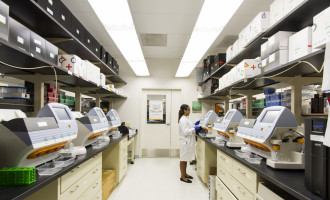
Cutaneous T-cell lymphoma (CTCL) is an incurable, rare cancer of skin-homing T cells that is highly disfiguring and lethal at advanced stages.
The most common form of CTCL, mycosis fungoides, is characterised by a cutaneous patch, plaque and/or tumour lesions.
Another form, Sezary syndrome, is the leukaemic variant of CTCL with circulating malignant T cells in the blood.
Large cell transformation occurs in a subset of mycosis fungoides and Sezary patients heralding immediate transition to an aggressive large cell lymphoma.
However, given the rare nature of CTCL, gathering adequate tissue specimens to investigate the tumour microenvironment at large cell transformation has been a significant roadblock to potential therapeutic advances.
In a new article published in Cancer Discovery, a journal of the American Association for Cancer Research, Moffitt Cancer Center researchers shared a comprehensive multiomics study from a rare cohort of 56 patients with transformed CTCL and identified several genomic alterations and oncogenic programs that may be potential novel therapeutic targets.
“While cancer death rates have significantly declined for many common cancers in the past decade, there is a sobering underrepresentation of this success in rare cancers, such as CTCL, particularly in the vulnerable racial minority groups,” said study senior author Pei-Ling Chen, M.D., Ph.D., associate member of the Pathology and Cutaneous Oncology Departments and member of the Moffitt Cutaneous Lymphoma Multidisciplinary Clinic, one of the largest CTCL referral centres in the U.S.
Moffitt researchers, in collaboration with scientists at MD Anderson Cancer Center, performed multiomics profiling of 70 biopsies and 16 fresh tissue specimens from patients with transformed CTCL and investigated the tumour ecosystem using integrative approaches spanning whole exome sequencing, single-cell RNAseq and immune profiling by single-cell V(D)J sequencing and multiplex immunofluorescence studies.
The researchers discovered that the genomic landscape of transformed CTCL is characterised by a high tumour mutation burden and UV mutation signatures that are prognostic for survival.
Importantly, transformed CTCL samples from Black/African American patients showed significantly lower contribution of UV signatures and enrichment of mutation signatures that are associated with defective DNA mismatch repair.
The research team also identified several recurrently mutated pathways and exome-based driver events in transformed CTCL and showed dissimilarity in the genomic landscape of transformed T cells in skin versus leukaemic T cells in blood, revealing opportunities to exploit differential or synergistic therapeutic vulnerabilities in the two body compartments at advanced stage disease.
To interrogate the transformed CTCL tumour ecosystem at single-cell resolution, the researchers then profiled 34,912 cells from 16 fresh tissue biopsies by single-cell RNA and V(D)J sequencing.
The research team identified the core oncogenic programs that malignant T cells exploit at large cell transformation, including metabolic reprogramming toward oxidative phosphorylation, cellular plasticity, upregulation of MYC, E2F and macrophage migration inhibitory factor activities, and downregulation of MHC-I suggestive of immune surveillance escape.
These signatures were further validated by pharmacologic perturbation studies using novel small molecule inhibitors of oxidative phosphorylation and MUC and multiplex immunofluorescence imaging.
“While further validation in larger cohorts and pre-clinical models are needed, our investigation provides a key resource to the community with the largest collection of transformed CTCL samples studied to date, the first comprehensive compendium of genomic alterations at large cell transformation, a blueprint for dissecting the T-cell lymphoma tumour microenvironment at single-cell resolution and identifies potential prognostic signatures and novel therapeutic targets in transformed CTCL. We anticipate results from this study can be extrapolated to other T-cell lymphomas and will help usher novel immunotherapeutic strategies to combat this currently incurable cancer,” said Chen.
While racial disparity is well-known to exist in CTCL, with Black and African American patients showing worse clinical outcomes, potential biological factors underlying this disparity are poorly understood.
The researchers hope that their findings can provide insights into potential genomic correlate of this disparity.
Future studies involving larger sample size from the vulnerable population and research into their tumour microenvironment for predictive biomarkers and novel therapeutic targets will hopefully help reduce racial disparity in CTCL.